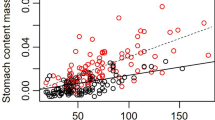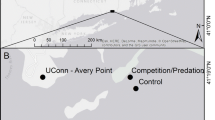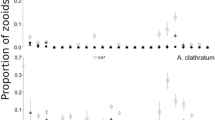Abstract
Daphnia lumholtzi has been very successful in colonizing North America since its appearance in Texas in 1990. Although previous studies have sought to link its success as an invasive species with various aspects of its population biology, there is little experimental data linking the invasion success of D. lumholtzi with its autecology, specifically its reproduction strategy. In this study we sought to link food quality and quantity to diapause in D. lumholtzi through a variation in phosphorus (P) content of algae, food quantity, and light level. We also assessed the effect of Daphnia peak population densities on reproductive rates and production of resting eggs. We found that when food is abundant, per capita ephippia production may be limited by P, but under food limitation conditions, there is no significant effect of food quality on ephippia production. Our results suggest that a combination of food quality/quantity and population density may work together to induce the production of resting eggs in this invasive species.



Similar content being viewed by others
References
Acharya, K., J. Jack & P. A. Bukaveckas, 2005. Dietary effects on life history of riverine Bosmina. Freshwater Biology 50: 965–975.
Acharya, K., J. Jack & A. S. Smith, 2006. Stoichiometry of Daphnia lumholtzi and their invasion success: are they linked?. Archiv für Hydrobiologie 165: 433–453.
Acharya, K., M. Kyle & J. J. Elser, 2004. Biological stoichiometry of Daphnia growth: an ecophysiological test of the growth rate hypothesis. Limnology and Oceanography 49: 656–665.
Alekseev, V., 2004. Effects of diel vertical migration on ephippia production in Daphnia. Journal of Limnology 63: 1–6.
Alekseev, V. & W. Lampert, 2001. Maternal control of resting-egg production in Daphnia. Nature 414: 899–901.
APHA, 1998. Standard methods for the examination of water and wastewater. American Public Health Association/Water Environment Federation, Washington, DC.
Arendt, J. D., 1997. Adaptive intrinsic growth rates: an integration across taxa. The Quarterly Review of Biology 72: 149–198.
Boersma, M. & C. Kreutzer, 2002. Life at the edge: Is food quality really of minor importance at low quantities? Ecology 83: 2552–2561.
Brendonck, L. & L. De Meester, 2003. Egg banks in freshwater zooplankton: Evolutionary and ecological archives in the sediment. Hydrobiologia 491: 65–84.
Brooks, J. L. & S. I. Dodson, 1965. Predation, body size, and composition of the plankton. Science 150: 28–35.
Cáceres, C., 1998. Interspecific variation in the abundance, production, and emergence of Daphnia diapausing eggs. Ecology 79: 1699–1710.
Cáceres, C. & A. J. Tessier, 2003. How long to rest: the ecology of optimal dormancy and environmental constraint. Ecology 84: 1189–1198.
Cáceres, C. & A. J. Tessier, 2004. Incidence of diapause varies among populations of Daphnia pulicaria. Oecologia 141: 425–431.
Carpenter, S. R. & J. F. Kitchell, 1984. Plankton community structure and limnetic primary production. American Naturalist 124: 159–172.
Chesson, P., 2000. Mechanisms of maintenance of species diversity. Annual Review of Ecology and Systematics 31: 343–366.
DeMott, W. R., R. D. Gulati & K. Siewertsen, 1998. Effects of phosphorus-deficient diets on the carbon and phosphorus balance of Daphnia magna. Limnology and Oceanography 43: 1147–1161.
Deng, H. W., 1996. Environmental and genetic control of sexual reproduction in Daphnia. Heredity 76: 449–458.
Dodson, S. I., 1990. Predicting diel vertical migration of zooplankton. Limnology and Oceanography 35: 1195–1200.
Ellner, S. P., N. G. Hairston Jr & D. Babaï, 1998. Long-term diapause and spreading of risk across the life cycle. Archiv für Hydrobiologie Special Issues Advances in Limnology 52: 297–312.
El Moghraby, A. I., 1977. A study on diapause of zooplankton in a tropical river–The Blue Nile. Freshwater Biology 7: 207–212.
Elser, J. J., K. Acharya, J. Cotner, W. Makina, T. Markow, T. Watts, S. Hobbie, W. Fagan, J. Schade & R. W. Sterner, 2003. Growth rates-stoichiometric couplings in diverse biota. Ecology Letters 6: 936–943.
Elser, J. J., H. Hayakawa & J. Urabe, 2001. Nutrient limitation reduces food quality for zooplankton: Daphnia response to seston phosphorus enrichment. Ecology 82: 898–903.
Færøvig, P. J. & D. O. Hessen, 2003. Allocation strategies in crustacean stoichiometry: the potential role of phosphorus in the limitation of reproduction. Freshwater Biology 48: 1782–1792.
Ferrari, D. C. & P. D. N. Hebert, 1982. The induction of sexual reproduction in Daphnia magna: genetic differences between arctic and temperate populations. Canadian Journal of Zoology 60: 2143–2148.
George, D. G. & R. W. Edwards, 1974. Population dynamics and production of Daphnia hyaline in a eutrophic reservoir. Freshwater Biology 4: 445–465.
Gersich, F. M. & D. L. Hopkins, 1986. Site-specific acute and chronic toxicity of ammonia to Daphnia magna Straus. Environmental Toxicology and Chemistry 5: 443–447.
Gilbert, J. J., 2003. Specificity of crowding response that induces sexuality in the rotifer Branchionus. Limnology and Oceanography 48: 1297–1303.
Gilbert, J. J. & D. Schreiber, 1995. Induction of diapausing amictic eggs in Synchaeta pectinata. Hydrobiologia 313/314: 345–350.
Gorokhova, E. & M. Kyle, 2002. Analysis of nucleic acids in Daphnia: development of methods and ontogenetic variations in RNA-DNA content. Journal of Plankton Research 24: 511–522.
Gulati, R. & W. Demott, 1997. The role of food quality for zooplankton: remarks on the state-of-the-art, perspectives, and priorities. Freshwater Biology 38: 753.
Hairston Jr., N. G., R. A. Van Brunt & C. M. Kearns, 1995. Age and survivorship of diapausing eggs in a sediment egg bank. Ecology 76: 1706–1711.
Havel, J. E., W. R. Mabee & J. R. Jones, 1995. Invasion of the exotic cladoceran Daphnia lumholtzi into North American reservoirs. Canadian Journal of Fisheries and Aquatic Sciences 52: 151–160.
Hebert, P. D. N., 1987. Genotypic characteristics of the Cladocera. Hydrobiologia 145: 183–193.
Innes, D. J. & D. R. Singleton, 2000. Variation in allocation to sexual and asexual reproduction among clones of cyclically parthenogenetic Daphnia pulex (Crustacea: Cladocera). Biological Journal of the Linnean Society 71: 771–787.
Johnson, J. & J. Havel, 2001. Competition between native and exotic Daphnia: in situ experiments. Journal of Plankton Research 43: 373–387.
Kiesecker, J. M. & A. R. Blaustein, 1997. Population differences in responses of red-legged frogs (Rana aurora) to introduced bullfrogs. Ecology 78: 1752–1760.
Kyle, M., K. Acharya, L. J. Weider, K. Looper & J. J. Elser, 2006. Coupling of growth rate and body stoichiometry in Daphnia: a role for maintenance processes? Freshwater Biology 51: 2087–2095.
McCauley, E., W. W. Murdoch & R. M. Nisbet, 1990. Growth, reproduction, and mortality of Daphniapulex Leydig: life at low food. Functional Ecology 4: 505–514.
Mergeay, J., D. Verschuren, L. Van Kerckhoven & L. De Meester, 2004. Two hundred years of a diverse Daphnia community in Lake Naivasha (Kenya): effects of natural and human-induced environmental change. Freshwater Biology 49: 998–1013.
Muzinic, C. J., 2000. First record of Daphnia lumholtzi Sars in the Great Lakes. Journal of Great Lakes Research 26: 352–354.
Riccardi, N., G. Giussani, F. Margaitora & B. Couchaud, 2004. Population dynamics of the pioneer population of Daphnia parvula, Fordyce during the invasion of Lake Candia (Northern Italy). Journal of Limnology 63: 44–52.
Schroder, T. & J. J. Gilbert, 2004. Transgenerational plasticity for sexual reproduction and diapause in the life cycle of monogonont rotifers: intraclonal, intraspecific and interspecific variation in the response to crowding. Functional Ecology 18: 458–466.
Slusarcyzk, M., 1995. Predator-induced diapause in Daphnia. Ecology 76: 1008–1013.
Slusarcyzk, M., 2004. Environmental plasticity of fish avoidance diapause response in Daphnia magna. Journal of Limnology 63: 70–74.
Slusarcyzk, M., P. Dawidowicz & E. Rygielska, 2005. Hide, rest or die: a light-mediated diapause response in Daphnia magna to the threat of fish predation. Freshwater Biology 50: 141–146.
Slusarcyzk, M. & E. Rygielska, 2004. Fish feces as the primary source of chemical cues inducing fish avoidance diapause in Daphnia magna. Archiv für Hydrobiologie 526: 231–234.
Sommer, U., Z. M. Gliwicz, W. Lampert & A. Duncan, 1986. The PEG-model of seasonal succession of planktonic events in fresh waters. Archiv für Hydrobiologie 106: 433–471.
Sorensen, K. H. & R. W. Sterner, 1992. Extreme cyclomorphosis in Daphnia lumholtzi. Freshwater Biology 28: 257–262.
Starkweather, P. L., 1978. Diel variation in feeding behavior of Daphnia pulex. Influences of food density and nutritional history on mandibular activity. Limnology and Oceanography 23: 307–317.
Sterner, R. W. & J. Robinson, 1994. Thresholds for growth in Daphnia magna with high and low phosphorus diets. Limnology and Oceanography 39: 1229–1233.
Strayer, D. L., K. A. Hattala & A. W. Kahnle, 2004. Effects of an invasive bivalve (Dreissena polymorpha) on fish in the Hudson River estuary. Canadian Journal of Fisheries and Aquatic Sciences 61: 924–941.
Stross, R. G. & J. C. Hill, 1965. Diapause induction in Daphnia requires two stimuli. Science 150: 1462–1464.
Urabe, J., M. Kyle, W. Makino, T. Yoshida, T. Anderson & J. J. Elser, 2002. Reduced light increases herbivore production due to stoichiometric effects of light/nutrient balance. Ecology 83: 619–627.
Wagner, C. M., M. L. Jones, M. B. Twohey & P. W. Sorensen, 2006. A field test verifies that pheromones can be useful for sea lamprey (Petromyzon marinus) control in the Great Lakes. Canadian Journal of Fisheries and Aquatic Sciences 63: 475–479.
Williamson, C. E. & L. J. Stoeckel, 1989. Predation risk and the structure of fresh-water zooplankton communities. Oecologia 79: 76–82.
Author information
Authors and Affiliations
Corresponding author
Additional information
Handling editor: S. Declerk
Rights and permissions
About this article
Cite this article
Smith, A.S., Acharya, K. & Jack, J. Overcrowding, food and phosphorus limitation effects on ephipphia production and population dynamics in the invasive species Daphnia lumholtzi . Hydrobiologia 618, 47–56 (2009). https://doi.org/10.1007/s10750-008-9546-2
Received:
Revised:
Accepted:
Published:
Issue Date:
DOI: https://doi.org/10.1007/s10750-008-9546-2




